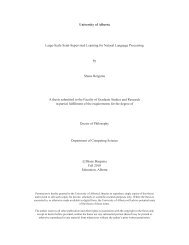The high altitude wildlife areas of western Arunachal Pradesh
The high altitude wildlife areas of western Arunachal Pradesh
The high altitude wildlife areas of western Arunachal Pradesh
You also want an ePaper? Increase the reach of your titles
YUMPU automatically turns print PDFs into web optimized ePapers that Google loves.
Conservation status<br />
pheasants, etc.), conversations with some villagers suggested that the extent <strong>of</strong> hunting<br />
may indeed have declined.<br />
Human presence and natural resource extraction<br />
In addition to hunting, we found many other forms <strong>of</strong> natural resource use and<br />
extraction among the resident people. A majority <strong>of</strong> the forest area is under the<br />
traditional ownership and de facto control <strong>of</strong> the village councils. On the other hand,<br />
individual families or groups <strong>of</strong> families seem to have usufruct rights over a major<br />
fraction <strong>of</strong> the grazing land, with remaining pastures belonging to the village councils.<br />
<strong>The</strong> <strong>high</strong> <strong>altitude</strong> meadows, which are open hill slopes above the tree line at <strong>altitude</strong>s<br />
between 4200 and 5250 m, are used for summer livestock grazing. Further, open<br />
alpine grasslands and krummholz Rhododendron vegetation occur between 4000 m<br />
and 4500 m and are used for summer grazing (see Chapter 3). In <strong>areas</strong> between 2500<br />
to 4200 m, forests have been cleared in the past to create grazing land. <strong>The</strong>se grassy<br />
meadows in forest clearings seem to be maintained by livestock grazing. We found<br />
that the practice <strong>of</strong> cutting and burning forests to create grazing <strong>areas</strong> continues to the<br />
present day. <strong>The</strong> entire <strong>high</strong> <strong>altitude</strong> pastures are used for summer grazing by yak,<br />
cattle-yak hybrids and sheep, whereas the lower <strong>altitude</strong> forests and meadows in forest<br />
clearings are mostly grazed by mithun, cattle, mithun-cattle hybrids, and mithun-yak<br />
hybrids.<br />
<strong>The</strong> forests are also used by people to collect fuelwood, timber, bamboo for<br />
house-building, and to gather oak leaf litter for manure. In <strong>areas</strong> such as Mukto and<br />
the Lower Nyamjang Chu Valley, timber and firewood are commercially traded, with<br />
fir Abies densa being the most sought after timber species. This trade is largely<br />
unregulated. In the <strong>high</strong>er <strong>areas</strong>, Rhododendron shrubs and tress are particularly<br />
sought-after as fuel-wood since they burn well even when fresh. Leaves and small<br />
branches are regularly gathered from Juniperus, a plant <strong>of</strong> ritual significance in local<br />
Buddhist culture. In many villages, the village councils locally administer some<br />
regulation on collection <strong>of</strong> bamboo and other forms <strong>of</strong> extraction.<br />
Collection <strong>of</strong> medicinal plants from the <strong>high</strong> <strong>altitude</strong> meadows, as well as the<br />
forests, seems to be an important source <strong>of</strong> cash income for the villagers, especially in<br />
the <strong>high</strong>er reaches <strong>of</strong> West Kameng. <strong>The</strong> main species in trade are Swertia sp., Taxus<br />
sp., Dactylorhiza sp., Cordyceps sp., Rubia sp., and Picrorrhiza sp. Villagers reported a<br />
rapid decline in the abundance <strong>of</strong> medicinal plants due to unregulated collection. In<br />
particular, Taxus sp., an endangered tree, appears to have undergone drastic<br />
population decline. Ilicium griffithi fruits, used as a spice, also constitute an important<br />
source <strong>of</strong> income for the villagers. Although the forest department does not own most<br />
<strong>of</strong> these forests, it does charge royalties on commercial produce gathered from<br />
village/community forests. In the Bomdila Forest Division <strong>of</strong> West Kameng, such<br />
royalty earning from the trade in medicinal plants last year was estimated at about Rs.<br />
4 million (Shambhu, pers. comm.). Although recently, the forest department has<br />
temporarily stopped issuing permits to traders for transporting medicinal plants, the<br />
collection at the local level continues.<br />
We found the existence <strong>of</strong> very small (< 100 ha) sacred forests near Tawang<br />
and Mukto, where no hunting or any other form <strong>of</strong> resource extraction is allowed.<br />
13

















